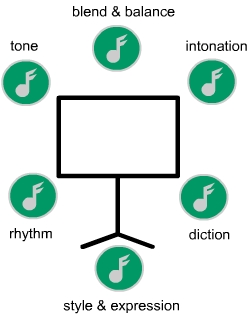|
|
|
|
 This
training program is divided into five separate units: 1)
introduction, 2) tutorials, 3) practice modules, 4) reflection,
and 5) assessment. The introduction provides an overview
of the training program. The tutorials present information,
demonstrations, and guided practice with an expert choral
educator. The practice modules allow the user to apply the
problem solving routine in simulated rehearsals. The unit
on reflection presents case-study scenarios to stimulate
reflective thinking about alternative problem-solving strategies
in relation to the user's own choices. The assessment unit
uses case-studies to help the user evaluate their success. This
training program is divided into five separate units: 1)
introduction, 2) tutorials, 3) practice modules, 4) reflection,
and 5) assessment. The introduction provides an overview
of the training program. The tutorials present information,
demonstrations, and guided practice with an expert choral
educator. The practice modules allow the user to apply the
problem solving routine in simulated rehearsals. The unit
on reflection presents case-study scenarios to stimulate
reflective thinking about alternative problem-solving strategies
in relation to the user's own choices. The assessment unit
uses case-studies to help the user evaluate their success.
|
|
|
Unit
One:
|
Introduction
In this unit, the learner will be presented with background
information about the program, instructions on how to use
the program, and the rationale for learning and applying
a problem solving routine to develop choral conducting skills
within live choral sessions.
|
| |
|
| Unit
Two: |
Tutorials
This unit consists of three separate components. In part
one, the learner will be introduced to a six-step problem
solving routine to help them acquire effective decision
making skills. In part two, the learner will view a demonstration
leading them through each step of the problem solving routine.
In part three, the learner will be presented with a series
of videotaped rehearsal segments where they will apply the
problem solving routine while obtaining specific feedback
regarding their decisions.
|
| |
|
| Unit
Three: |
Practice
Modules
In this unit, the learner will be presented with several
simulated rehearsals where they will employ the problem
solving routine to each situation. Upon completion of each
simulated rehearsal, the learner will be given the opportunity
to 1) respond to a series of questions about the decisions
that they have made and explain the rationale for their
decisions and 2) engage in an interactive analysis with
guided response and feedback.
|
| |
|
| Unit
Four: |
Reflection
In this unit, the learner will revisit simulated rehearsals
where they have previously employed the problem solving
routine. Upon reviewing each rehearsal, the learner will
be given the opportunity to 1) engage in reflective thinking
simulations where they compare their own decisions to an
expert's, and 2) review several case-study scenarios designed
to stimulate reflective thinking about alternative problem-solving
strategies.
|
| |
|
| Unit
Five: |
Assessment
In this unit, the learner will be presented with
several case-study scenarios and test items to assess their
ability to apply the problem solving routine to new learning
situations. Each test item will evaluate the users' ability
to: correctly isolate the problem area, identify the source
of the problem, diagnosis the cause of the problem, solve
the problem, place the solution back into context, provide
adequate feedback, reflect on their problem solving skills,
and explain the rationale for their responses. Students
who repeatedly show inconsistent patterns in employing the
decision-making strategy will be redirected to additional
training units for remediation.
|
| |
|
|
